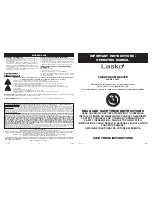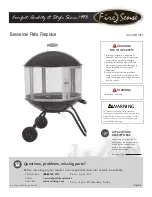
34
Installation & Service Manual
4
System piping
Incorrect piping of the cold water supply to the system
may result in excessive low temperature operation causing
condensate formation on the heat exchanger and operational
problems. The cold water supply piping must be installed in
the discharge piping from the heater to the storage tank.
This allows the cold water to be tempered in the storage
tank before entering the heater. See typical installation
drawings provided with the appliance for correct piping.
Higher water temperatures reduce condensate formation.
CAUTION
Setting the temperature selector to
higher settings provides hotter water,
which increases the risk of scald injury
.
This water heater can deliver scalding temperature water
at any faucet in the system. Be careful whenever using hot
water to avoid scalding injury. Certain appliances such as
dishwashers and automatic clothes washers may require
increased temperature water. By setting the thermostat on
this water heater to obtain the increased temperature water
required by these appliances, you may create the potential
for scald injury. To protect against injury, you should
install an ASSE approved mixing valve in the water system.
This valve will reduce point of discharge temperature by
mixing cold and hot water in branch supply lines. Such
valves are available from the local plumbing supplier.
The following chart (Table 4D) details the relationship of
water temperature and time with regard to scald injury
and may be used as a guide in determining the safest water
temperature for your applications.
TABLE 4D
APPROXIMATE TIME / TEMPERATURE
RELATIONSHIPS IN SCALDS
120°F
More than 5 minutes
125°F
1 1/2 to 2 minutes
130°F
About 30 seconds
135°F
About 10 seconds
140°F
Less than 5 seconds
145°F
Less than 3 seconds
150°F
About 1 1/2 seconds
155°F
About 1 second
WARNING
Should overheating occur or the gas
supply fail to shut off, do not turn off or
disconnect the electrical supply to the
pump. Instead, shut off the gas supply
at a location external to the appliance.
Optional relief valve
The water heater is normally supplied with a temperature
and pressure relief valve(s) sized in accordance with
applicable codes. Appliances may be supplied with an
optional pressure only relief valve(s). When a water
heater equipped with this optional relief valve is piped to
a separate storage vessel, the storage vessel must have a
properly installed temperature and pressure relief valve
which complies with local codes.
A relief valve which discharges periodically may be due
to thermal expansion in a closed system. A water heater
installed in a closed system, such as one with a backflow
preventer or check valve installed in the cold water supply,
shall be provided with means to control expansion.
Contact the water supplier or local plumbing inspector
on how to correct this situation.
Do not plug or cap the
relief valve discharge!
Thermal expansion
Hydrogen gas can be produced in a hot water system that
has not been used for a long period of time (generally two
weeks or more).
Hydrogen gas is extremely flammable.
To prevent the possibility of injury under these conditions,
we recommend the hot water faucet be open for several
minutes at the kitchen sink before you use any electrical
appliance which is connected to the hot water system. If
hydrogen is present, there will be an unusual sound such
as air escaping through the pipe as the hot water begins to
flow. There should be no smoking or open flames near the
faucet at the time it is open.
Cathodic protection
Summary of Contents for Efficiency-Pac EW 150 -- 300
Page 47: ...47 Notes ...















































